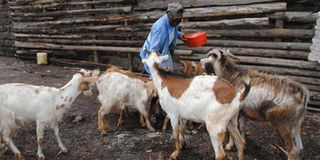Prepare dairy feeds for the dry spell as rains gather steam

A woman feeds her goats in Elburgon, Nakuru County. Feeds are the most expensive item in dairy production thus farmers must plan and put in place measures to conserve forage as it rains. PHOTO | JOHN NJOROGE | NATION MEDIA GROUP
What you need to know:
- Confirm the average weight of A hay bale to get the value for your money.
- The farmer should also put up ideal structures for feeds storage to protect them against water, excessive heat, weevils, birds and rodents.
- One-meter cube of well-compacted silage can give approximate 500kg of silage when settled while one acre of good maize crop can give 10 tonnes of silage.
- This being the harvesting season, farmers should consider harvesting or buying and storing feeds since after the rainy season, a dry spell would set in.
Weeks have passed since many parts of the country started receiving continuous rains following a dry spell.
During the dry weather, many farmers were adversely hit by the drought effects, with some not only losing production but also the animals.
However, while many dairy farmers lamented, what they did not know was that the drought presented a bright opportunity to plan their feed resources.
Those who had planned well doubled their milk production and thus income. Others now have a great opportunity to supply breeding stock to those who wish to restock their herds.
Now, as the rains peak, many parts of the country have turned green with animal feed resources improving.
Feeds are the most expensive item in dairy production thus farmers must plan and put in place measures to conserve forage as it rains.
The farmer needs to ask himself a number of questions before planning on feeds.
First is the breed of animals being kept, the number of animals to be fed, the type of feeds to conserve, the quantities of feeds for each category of animal, which is the best form to conserve the feed, the duration to feed the animals and the cost involved.
The farmer should also put up ideal structures for feeds storage to protect them against water, excessive heat, weevils, birds and rodents.
Some feed materials can best be conserved as silage while others as hay.
Depending on the material to be stored, one may be required to process it by either drying, chopping, grinding or even adding some additives and insecticides.
For example, materials to be ensilaged may require addition of a carbohydrate like molasses, ground maize flour, maize germ, other forms of sugar or even a bacterial culture while hay, cereals, cereal by-products and concentrate feeds are dried to reduce moisture content before storage.
MAKE HAY WHILE SUN SHINES
Ability to estimate the feed requirement for the animals for a given period of time is of significant importance in determining a farm’s requirements.
One-meter cube of well-compacted silage can give approximate 500kg of silage when settled while one acre of good maize crop can give 10 tonnes of silage.
By considering the number of animals to be fed, the quantities fed per day and the duration of feeding, the farmer can not only estimate the quantity of silage needed but also the acreage of land required to grow sufficient quantities of fodder to meet needs for a given period.
A standard hay bale weighs between 18 and 22kg. Confirming the average weight of hay bale is important to determine value for money as some commercial hay dealers are bailing as low as 11kg.
Using a similar approach, the farmer can estimate the number of hay or Lucerne bales needed as follows: Number of hay bales required is equal to the number of animals to be fed times the amount fed per day times the feeding duration divided by weight of a bale.
Similarly, other feeds resources estimates can be calculated for different breeds of livestock.
The advantages of making hay while the sun shine are enormous.
They include lowering production costs as feeds are bought and conserved during the time when the price is low, and farmers can plan to have consistent production throughout the year ensuring steady income.
Further, farmers can plan their animals’ maximum production to coincide with the time the market price of milk and meat is at the peak.
This being the harvesting season, farmers should consider harvesting or buying and storing feeds since after the rainy season, a dry spell would set in.
Musyoka is based at the Department of Animal Sciences, Egerton University.




